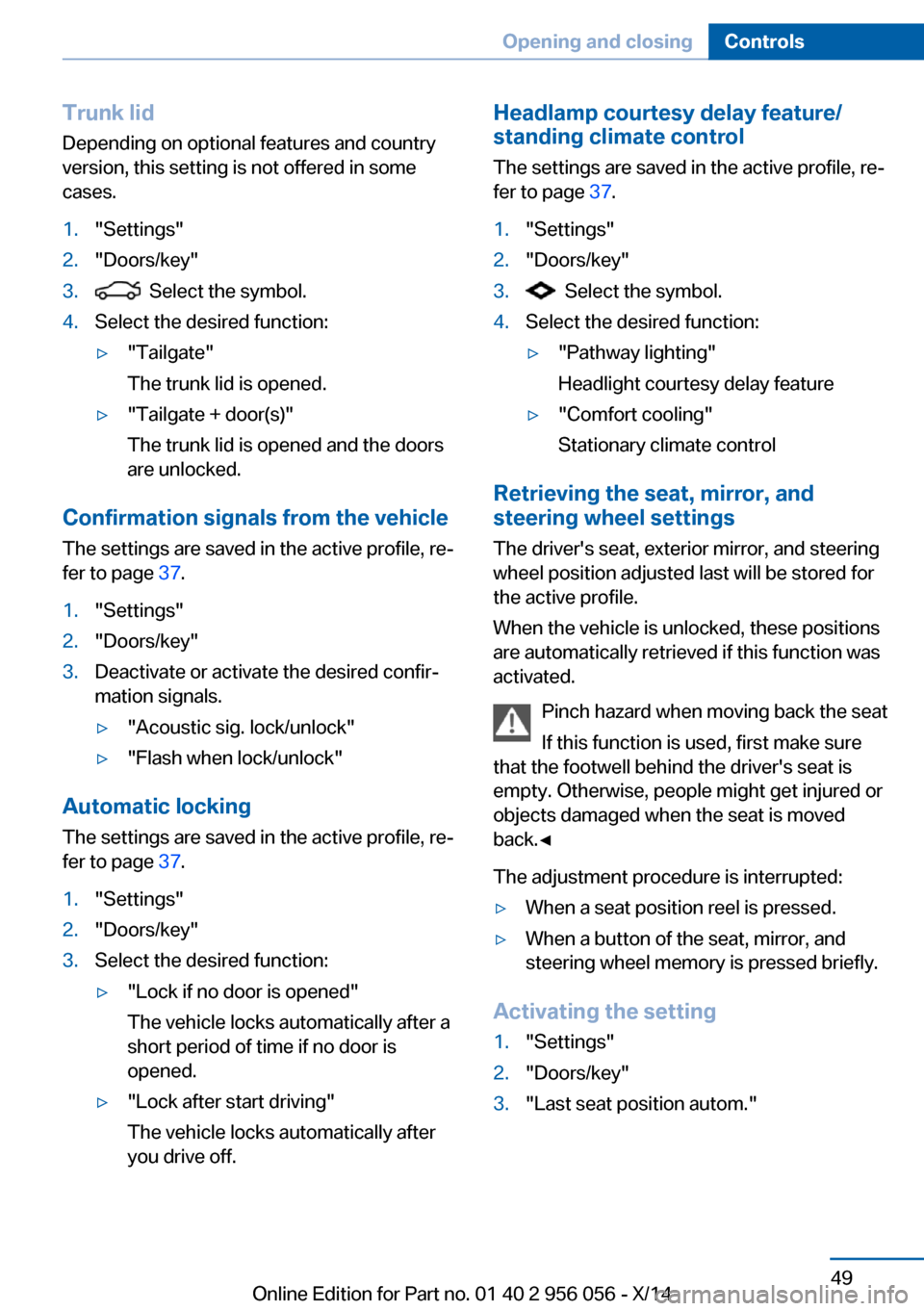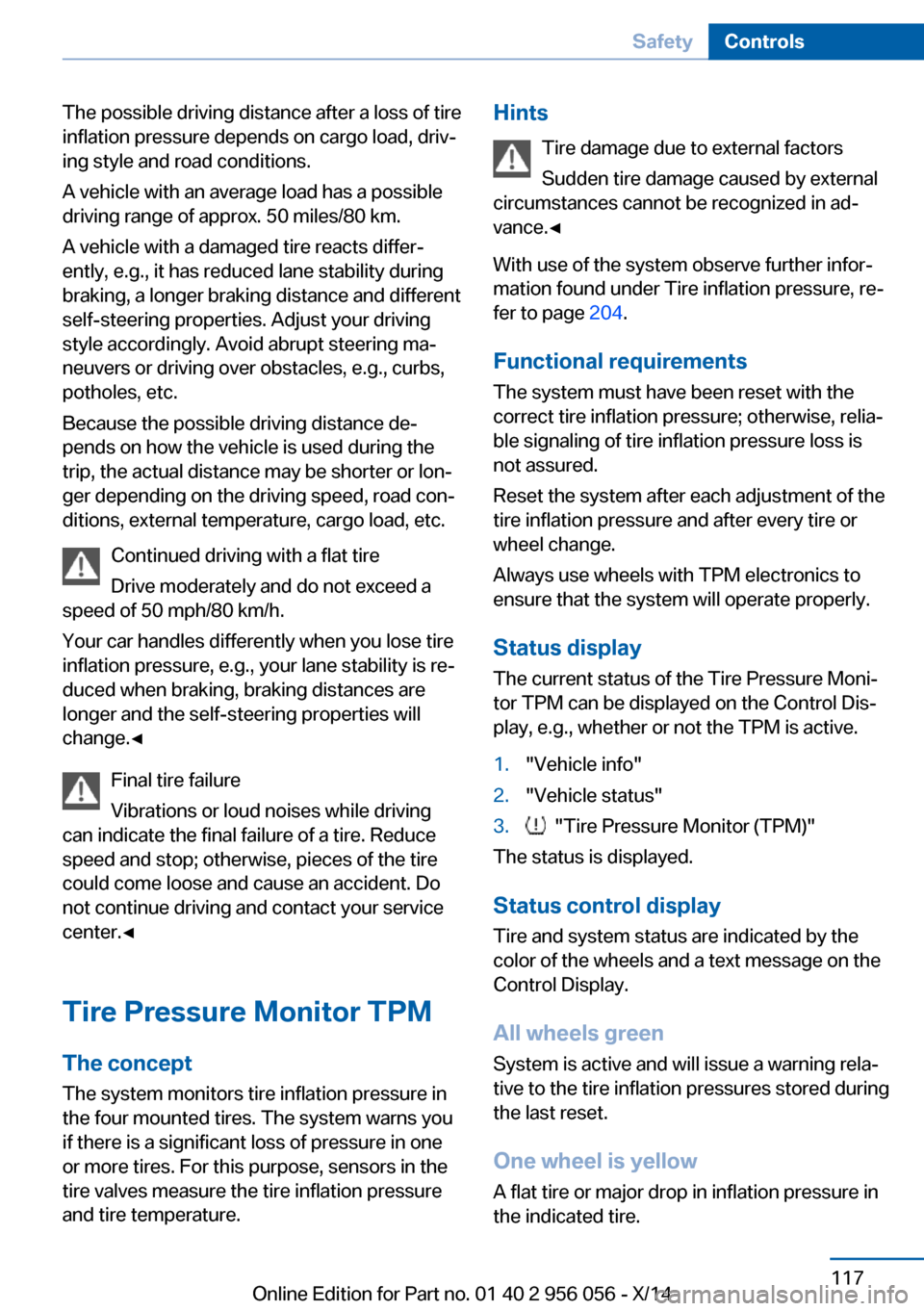steering wheel adjustment BMW ACTIVE HYBRID 7 2014 F01H Owner's Manual
[x] Cancel search | Manufacturer: BMW, Model Year: 2014, Model line: ACTIVE HYBRID 7, Model: BMW ACTIVE HYBRID 7 2014 F01HPages: 257, PDF Size: 5.44 MB
Page 53 of 257

Trunk lid
Depending on optional features and country
version, this setting is not offered in some
cases.1."Settings"2."Doors/key"3. Select the symbol.4.Select the desired function:▷"Tailgate"
The trunk lid is opened.▷"Tailgate + door(s)"
The trunk lid is opened and the doors
are unlocked.
Confirmation signals from the vehicle
The settings are saved in the active profile, re‐
fer to page 37.
1."Settings"2."Doors/key"3.Deactivate or activate the desired confir‐
mation signals.▷"Acoustic sig. lock/unlock"▷"Flash when lock/unlock"
Automatic locking
The settings are saved in the active profile, re‐fer to page 37.
1."Settings"2."Doors/key"3.Select the desired function:▷"Lock if no door is opened"
The vehicle locks automatically after a
short period of time if no door is
opened.▷"Lock after start driving"
The vehicle locks automatically after
you drive off.Headlamp courtesy delay feature/ standing climate control
The settings are saved in the active profile, re‐fer to page 37.1."Settings"2."Doors/key"3. Select the symbol.4.Select the desired function:▷"Pathway lighting"
Headlight courtesy delay feature▷"Comfort cooling"
Stationary climate control
Retrieving the seat, mirror, and
steering wheel settings
The driver's seat, exterior mirror, and steering
wheel position adjusted last will be stored for
the active profile.
When the vehicle is unlocked, these positions
are automatically retrieved if this function was
activated.
Pinch hazard when moving back the seat
If this function is used, first make sure
that the footwell behind the driver's seat is
empty. Otherwise, people might get injured or
objects damaged when the seat is moved
back.◀
The adjustment procedure is interrupted:
▷When a seat position reel is pressed.▷When a button of the seat, mirror, and
steering wheel memory is pressed briefly.
Activating the setting
1."Settings"2."Doors/key"3."Last seat position autom."Seite 49Opening and closingControls49
Online Edition for Part no. 01 40 2 956 056 - X/14
Page 121 of 257

The possible driving distance after a loss of tire
inflation pressure depends on cargo load, driv‐
ing style and road conditions.
A vehicle with an average load has a possible
driving range of approx. 50 miles/80 km.
A vehicle with a damaged tire reacts differ‐
ently, e.g., it has reduced lane stability during
braking, a longer braking distance and different
self-steering properties. Adjust your driving
style accordingly. Avoid abrupt steering ma‐
neuvers or driving over obstacles, e.g., curbs,
potholes, etc.
Because the possible driving distance de‐
pends on how the vehicle is used during the
trip, the actual distance may be shorter or lon‐
ger depending on the driving speed, road con‐
ditions, external temperature, cargo load, etc.
Continued driving with a flat tire
Drive moderately and do not exceed a
speed of 50 mph/80 km/h.
Your car handles differently when you lose tire
inflation pressure, e.g., your lane stability is re‐
duced when braking, braking distances are
longer and the self-steering properties will
change.◀
Final tire failure
Vibrations or loud noises while driving
can indicate the final failure of a tire. Reduce
speed and stop; otherwise, pieces of the tire
could come loose and cause an accident. Do
not continue driving and contact your service
center.◀
Tire Pressure Monitor TPM
The concept
The system monitors tire inflation pressure in
the four mounted tires. The system warns you
if there is a significant loss of pressure in one
or more tires. For this purpose, sensors in the
tire valves measure the tire inflation pressure
and tire temperature.Hints
Tire damage due to external factors
Sudden tire damage caused by external
circumstances cannot be recognized in ad‐
vance.◀
With use of the system observe further infor‐
mation found under Tire inflation pressure, re‐
fer to page 204.
Functional requirements
The system must have been reset with the
correct tire inflation pressure; otherwise, relia‐
ble signaling of tire inflation pressure loss is
not assured.
Reset the system after each adjustment of the
tire inflation pressure and after every tire or
wheel change.
Always use wheels with TPM electronics to
ensure that the system will operate properly.
Status display
The current status of the Tire Pressure Moni‐
tor TPM can be displayed on the Control Dis‐
play, e.g., whether or not the TPM is active.1."Vehicle info"2."Vehicle status"3. "Tire Pressure Monitor (TPM)"
The status is displayed.
Status control display Tire and system status are indicated by the
color of the wheels and a text message on the
Control Display.
All wheels green System is active and will issue a warning rela‐
tive to the tire inflation pressures stored during
the last reset.
One wheel is yellow A flat tire or major drop in inflation pressure in
the indicated tire.
Seite 117SafetyControls117
Online Edition for Part no. 01 40 2 956 056 - X/14
Page 122 of 257

All wheels are yellowA flat tire or major drop in inflation pressure in
several tires.
Wheels, gray The system cannot detect a flat tire. Reasons
for this may be:▷The system is being reset.▷Malfunction.
Status information
The status control display additionally shows
the current tire inflation pressures and possibly
tire temperatures. It shows the actual values
read; they may vary depending on driving style or weather conditions.
Carry out reset
Reset the system after each adjustment of the
tire inflation pressure and after every tire or
wheel change.
On the Control Display and on the vehicle:
1."Vehicle info"2."Vehicle status"3. "Perform reset"4.Start the engine - do not drive off.5.Reset tire inflation pressure:"Perform
reset".6.Drive away.
The tires are shown in gray and the status is
displayed.
After driving faster than 19 mph/30 km/h for a
short period, the set tire inflation pressures are
accepted as reference values. The reset is
completed automatically while driving.
After a successfully completed Reset, the
wheels on the Control Display are shown in
green and "Tire Pressure Monitor (TPM)
active" is displayed.
You may interrupt this trip at any time. When
you continue the reset resumes automatically.
Low tire pressure message
The yellow warning lamp lights up. A
Check Control message is displayed.▷There is a flat tire or a major loss in
tire inflation pressure.▷No reset was performed for the system.
The system therefore issues a warning
based on the tire inflation pressures before
the last reset.1.Reduce your speed and stop cautiously.
Avoid sudden braking and steering maneu‐
vers.2.Check whether the vehicle is fitted with
regular tires or run-flat tires.
Run-flat tires, refer to page 210, are la‐
beled with a circular symbol containing the
letters RSC marked on the tire's sidewall.
Do not continue driving without run-flat
tires
Do not continue driving if the vehicle is not
equipped with run-flat tires; continued driving
may result in serious accidents.◀
A low tire inflation pressure might turn on DSC
Dynamic Stability Control.
Actions in the event of a flat tireNormal tires
1.Identify the damaged tire.
Do this by checking the air pressure in all
four tires.
If the tire inflation pressure in all four tires
is shown to be correct, it is possible that
the Tire Pressure Monitor did not perform
a reset. Then perform the reset.
If an identification is not possible, please
contact the service center.2.Fixing a flat tire, where applicable with the
Mobility System.Seite 118ControlsSafety118
Online Edition for Part no. 01 40 2 956 056 - X/14
Page 246 of 257

Everything from A to Z
IndexA ABS, Antilock Brake Sys‐ tem 138
ACC, Active Cruise Control with Stop & Go 144
Activated-charcoal filter 168
Activate drive readiness 76
Active Blind Spot Detec‐ tion 134
Active Cruise Control with Stop & Go, ACC 144
ActiveHybrid, system 31
Active Protection 135
Active seat, front 58
Active seat ventilation, front 59
Active seat ventilation, rear 62
Adapting to the course of the road, hybrid system 93
Adaptive brake lights, refer to Brake force display 135
Adaptive Light Control 108
Adaptive Light Control, bulb replacement 223
Additives, oil 215
Adjusting, steering wheel 69
Adjustments, seats/head re‐ straints 56
After washing vehicle 235
Airbags 112
Airbags, indicator/warning light 113
Air circulation, refer to Recir‐ culated-air mode 167
Air, dehumidifying, refer to Cooling function 167
Air distribution, manual 166
Air flow, automatic climate control 166 Air outlets, see ventila‐
tion 168
Air pressure, tires 204
Alarm system 50
Alarm, unintentional 51
All around the center con‐ sole 16
All around the roofliner 17
All around the steering wheel 14
All-season tires, refer to Win‐ ter tires 209
Alternating-code hand-held transmitter 174
Alternative oil types 216
Ambient light 110
Animal detection, see Night Vision 129
Antifreeze, washer fluid 86
Antilock Brake System, ABS 138
Anti-slip control, refer to DSC 138
Approved axle load 241
Approved engine oils 216
Armrest, refer to Center arm‐ rest 180
Arrival time 102
Ashtray 175
Assistance for the combus‐ tion engine, ASSIST 79
Assistance for the combus‐ tion engine, eBOOST 79
Assistance, Roadside Assis‐ tance 229
Assistance when driving off 138
ASSIST, assistance for the combustion engine 79
Attentiveness assistant 136
AUTO H button 80 AUTO H button, refer to Au‐
tomatic Hold 80
AUTO intensity 166
Automatic car wash 234
Automatic climate con‐ trol 165
Automatic Cruise Control with Stop & Go 144
Automatic Curb Monitor 68
Automatic deactivation, front- seat passenger airbags 114
Automatic deactivation of the hybrid system 233
Automatic engine start-stop function 77
Automatic headlight con‐ trol 108
Automatic Hold 80
Automatic locking 49
Automatic recirculated-air control 167
Automatic Soft Closing, doors 42
Automatic Soft Closing, trunk lid 43
Automatic transmission, see Steptronic transmission 87
Automatic trunk lid 43
AUTO program, automatic cli‐ mate control 166
AUTO program, intensity 166
Auxiliary air conditioning 172
Average fuel consump‐ tion 102
Average speed 102
Axle loads, weights 241
B Backrest curvature, refer to Lumbar support 57 Seite 242ReferenceEverything from A to Z242
Online Edition for Part no. 01 40 2 956 056 - X/14